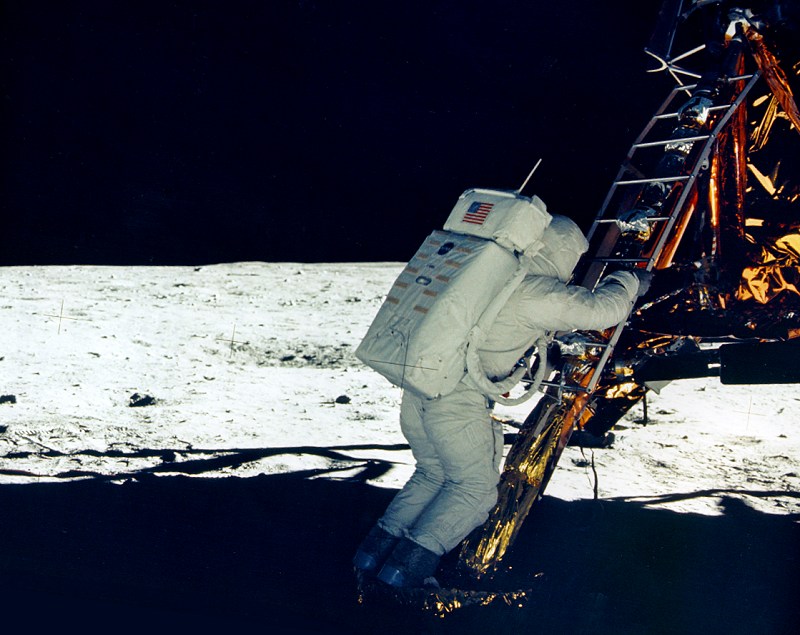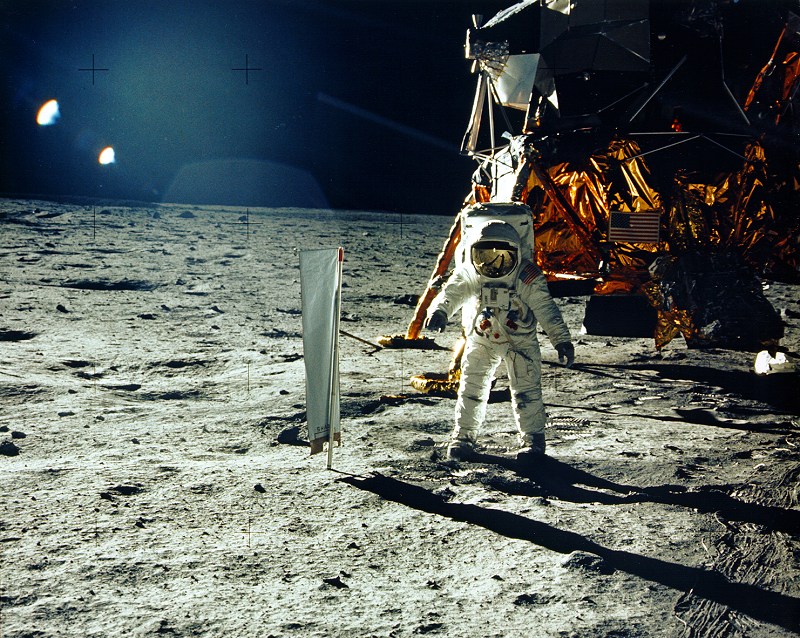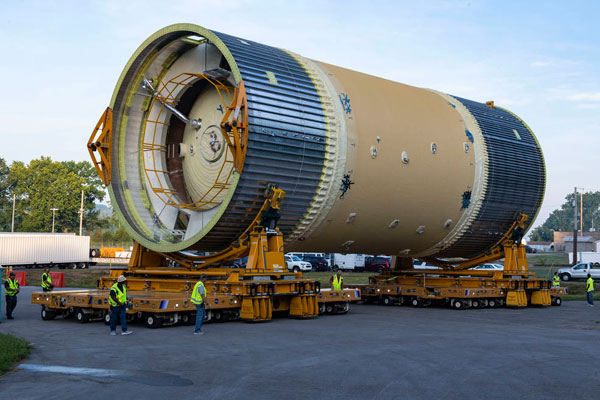July 20, 2019, marks the 50th anniversary of Apollo 11, the first mission that successfully landed on the Moon. It's only fitting that NASA is now working toward sending astronauts back. Let's look back at the history of the first landing, and then forward toward NASA's Gateway and beyond.
Happy 50th, Apollo!
July 20, 2019 is the anniversary of the Apollo program’s most symbolic achievement — putting human beings on the Moon. In 1969, Neil Armstrong and Buzz Aldrin walked on the surface of the Moon as Michael Collins waited in orbit. When Neil Armstrong spoke the words, "That's one small step for man, one giant leap for mankind,” he renewed humanity’s drive to reach beyond Earth. As President John F. Kennedy had put it seven years earlier, “We choose to go to the moon in this decade and do the other things not because they are easy, but because they are hard.”

NASA
NASA is planning a host of activities in July to celebrate the 50th anniversary of the Moon landing. The Apollo/Saturn V Center at the Kennedy Space Center in Florida has received a makeover in advance of the celebration; now, guests will be able to explore a 3D model of the lander, leave their own footprints on a "lunar surface," and even touch a real Moon rock. If you aren’t in Florida this July, check out NASA’s website for a list of anniversary events throughout the U.S. to find a celebration near you.
What Did We Learn From Apollo 11?
In 1969, we proved we could land on the Moon. But what else did we learn?
After Armstrong and Aldrin landed on the lunar surface, they collected samples of lunar “soil” (or regolith) to return home for study. These experiments helped us determine the exact composition of the moon — and unfortunately, it is not made of cheese. When the samples were brought back home, scientists were able to measure the density, grain size, and other properties of the regolith.

NASA
They also took samples of the solar wind, using something you probably have in your kitchen — aluminum foil! The foil panel collected the atomic particles released by the sun so that scientists could figure out what exactly made up the solar winds. Back on Earth, scientists were able to measure isotopes of light noble gases in the solar wind, including helium, neon, and argon.
In addition to taking samples, Armstrong and Aldrin left behind seismometers to monitor moonquakes. Powered by solar panels, the last of these sensors shut down in 1981. They also left behind some lunar retroreflectors, which have helped astronomers determine the exact distance between Earth and our nearest natural satellite.
Returning to the Moon
Since the Apollo 11 landing, we’ve experienced 50 years of aerospace innovation and advancements — but we haven’t gone back to the Moon since Apollo 17’s crew landed in 1972. Rejoice, space fans — that's about to change. But returning astronauts to the Moon is still one of the most difficult things we’ll do in the next decade.

NASA / Tony Gray and Kevin O’Connell
The Greek god Apollo may have brought us to the moon for the first time, but it's his twin sister Artemis that will be taking us back. NASA unveiled the Artemis program in May 2019, detailing what we could expect to see between now and when the craft is supposed to touch down on the lunar surface in 2024. NASA will use all means necessary to land at least two astronauts — the next man and the first woman— at the Moon’s south pole by 2024, as well as establish a sustainable presence on the satellite by 2028.
“Through the Artemis program, we will go to the Moon in a way we have never gone before – with innovative new technologies and systems to explore the entire lunar surface,” says Sean Potter, Media Relations Specialist at NASA.
“While we do not anticipate setbacks,” Potter adds, “we are prepared to deal with any that may arise by working strategically with our partners to find solutions to ensure we meet our end goals.”
Crew will ultimately fly to the Moon in the Orion capsule, which will perch atop the Space Launch System (SLS). An uncrewed flight of the Orion capsule was tested aboard the Delta IV Heavy rocket in 2014. The SLS is still under development and should make its maiden voyage — still uncrewed — in 2020. The first crewed flight with Orion atop the SLS, carrying four astronauts is currently set for 2022.

NASA / Fred Deaton
The first few Artemis missions will begin construction of a space station in cislunar orbit. If all goes according to plan, by 2024 a team of astronauts will fly to that space station, then touch down on the lunar surface.
Destination: Gateway
While NASA's current goal is to bring astronauts on the Moon by 2024, that's not the finish line. The lunar station, known as the Gateway, may also serve as a launch point for deep space missions, carrying astronauts to Mars and beyond. Potter told Sky & Telescope, “NASA has been studying the architecture needed to get us back to the Moon for a long time, and we will use the systems and technology we test and develop at the Moon for exploration farther into the solar system, including Mars.”

NASA
The Gateway will be a fraction of the size of the International Space Station that orbits our home planet. While the ISS is 109 meters long and 73 meters wide — about the size of an American football field — the Gateway will be much smaller, only 35 meters long and 5 meters wide.
However, that doesn’t mean it has a small role to play. As part of Artemis Phase 1 — getting astronauts to the moon by 2024 — the Gateway will provide a waystation for the astronauts when they arrive in orbit around our closest neighbor. The Artemis crew will consist of four astronauts, two descending to the lunar surface and two remaining on the Gateway. The station's minimal life support functions won’t be able to handle much more than that, at least to start.
Plus, there’s more in store for Phase 2, which includes setting up our permanent presence on the moon by 2028. “An expanded Gateway developed in Phase 2 could also function as a deep space laboratory for international collaboration, lunar science and technology advancement,” Potter notes.
We'll have to wait and see whether NASA can stick to the deadlines given the funding provided.
Right to the Moon
We've come a long way since Neil Armstrong first walked on the Moon. To put it all in perspective, the Apollo Guidance Computer had less memory than a modern-day calculator. Traveling to the Moon today with Apollo-era technology would be like trying to play Fortnite with your electric toothbrush. As we celebrate Apollo 11's 50th anniversary, it's good to look back on what we’ve learned, as well as look forward toward what else we can do. Even if we don't make it back to the moon by 2024, we're still heading in the right direction.
Happy 50th anniversary, Apollo, and thank you for everything you've taught us.
 0
0
Comments
You must be logged in to post a comment.